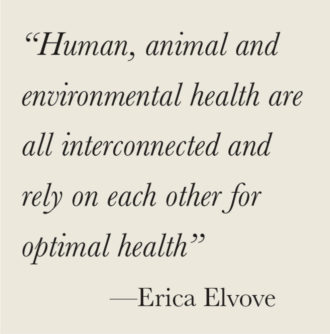
The Denver Zoo recently hired Erica Elvove to inspire the public to take action to save wildlife. Front Porch photo by Christie Gosch
The Denver Zoo has always had a mission of educating people about wildlife and the threats that various species face, but now officials want to take that mission a step further and transform the institution into a global leader for zoo-based conservation. Erica Elvove was recently hired to oversee that effort. For more than a decade, Elvove has been an innovator in the field of animal-assisted social work—a broad category of study that promotes the health and well-being of people, animals, and the environment. At the University of Denver, she helped create the Institute for Human-Animal Connection with the world’s first graduate program in human-animal-environment interaction. The institute’s program is a model for bringing together education, research and advocacy when it comes to animal-human connectivity.
She will have a similar mission at the zoo, where her primary goal is to create a vision and a strategy to expand the way the zoo engages and connects diverse audiences with wildlife conservation. “I want to inspire communities to take action for wildlife and ensure a healthier planet for future generations.”
 Elvove will be in charge of onsite and community-based education programs that highlight some of the zoo’s own field research around the globe. The goal, she says, is for people to see how connected they are to animals and the environment. “We want people to take that core message from the zoo and then we want to give them action items—specific steps they can take to benefit wildlife and the environment.” ‘
Elvove will be in charge of onsite and community-based education programs that highlight some of the zoo’s own field research around the globe. The goal, she says, is for people to see how connected they are to animals and the environment. “We want people to take that core message from the zoo and then we want to give them action items—specific steps they can take to benefit wildlife and the environment.” ‘
Elvove says she’s passionate about promoting the “one health” concept that originated in veterinary medicine, but applies to the social sciences as well. “Human, animal, and environmental health are all interconnected and rely on each other for optimal health. If we uplift one, the others will be uplifted. If we damage one, the others will suffer. My work bridges social work and conservation together.”
She hopes that if people realize that their own health and the health of the planet are inextricably linked, they will be more likely to feel the urgency of wildlife crisis. “There’s no doubt that more wildlife species are facing extinction. This is a critical time for our planet. It’s one of the reasons the zoo created this position and why I’m here.”
She also plans to work with businesses and non-profits to bring even more diversity to the zoo’s audience—so that people of all ages and backgrounds realize that they play an important role in wildlife conservation. “We want to make sure the zoo and its conservation work are accessible to all.”
The Denver Zoo currently has four core field conservation programs around the world where it works with local partners to improve wildlife habitat and protect threatened species. Here in Colorado, the zoo helps to improve grassland ecosystems by restoring bison populations, protecting wildlife migration corridors and encouraging outdoor enthusiasts to take part in a citizen scientist program designed to understand and mitigate the effects of climate change on alpine ecosystems. In Vietnam, the zoo works with local partners to promote the conservation and restoration of habitat for the imperiled Tonkin snub-nosed monkeys. In Peru, the zoo is leading scientific research and a public education about threats to frogs that live in Lake Titicaca and Lake Junin. And in Mongolia, researchers from the Denver Zoo are studying the impacts of climate change on argali sheep, goitered gazelle, vultures, falcons and marmots.



0 Comments